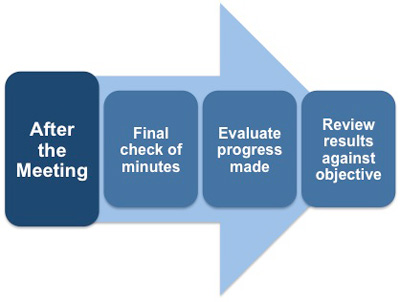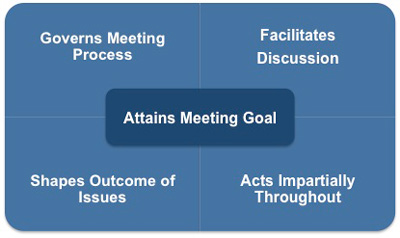Chairing a Meeting - Your Responsibilities After the Meeting
Your final tasks involve checking and evaluating what was achieved and how well the meeting objective was met.
 |
Before the meeting minutes are distributed, along with a Summary Action Sheet if applicable, you must ensure they are an accurate record of what took place and was agreed during the meeting. This is a key part of your role as Chair because the minutes will form the official record of events and in some cases a legal document.
It is always advisable to review the meeting process. Your method of review will depend on the nature of your meeting; sometimes a short email requesting feedback is adequate. This allows participants to offer suggestions for improvements for future meetings. This tends to work best with a small group that meets regularly, but can also be useful in other situations.
You should also conduct your own evaluation of how the meeting went and how well its objectives were met. Subjective feelings about the success or otherwise of a meeting can be misleading. Sometimes a meeting that went smoothly will turn out not to have achieved very much, whilst a meeting that felt acrimonious may have achieved most of its objectives.
You may also wish to discuss this type of event with your mentor or coach as part of your own personal development and reflect on how well the event was conducted. A key aspect of this process is to indicate aspects of the meeting you would handle differently now you have the benefit of hindsight.
As the Chair, your primary concern should be with the process of the meeting and not the substantive issues it has been called to address. Your role is one of an impartial facilitator, so you should not try to influence decisions made.
Your ongoing effectiveness as Chair will nearly always be more important than your ability to shape the outcome of any single issue. If you get embroiled in the debate concerning one or more issues, you risk losing your credibility and once lost this can prove impossible to regain.
 |
If you wish to have a motion tabled at a meeting that you are chairing, try enlisting another participant to actually make that point. Offering tacit support to someone else's case is a more effective tactic than making it yourself.
If you wish to influence the outcome of a particular debate, an effective tactic might be to seek approval for processes that are likely to favor your preferred outcome. If successful, you will be able to exert influence without expressing an opinion. In extreme circumstances, you may decide that it is necessary to sacrifice impartiality for what you see as the importance of helping the group decide on a certain course of action, but this is not something that you should do without careful consideration.
This Meeting Agenda Checklist outlines the five key areas you need to address to produce an effective agenda. This Meeting Attendee List Template provides you with a sheet to record everyone who needs to receive copies of meetings minutes. This Meeting Action List Template enables you to record actions, responsibilities and timescales that result from the meeting.
You may also be interested in:
Chairing a Meeting | The Skills Required to Chair a Meeting | Meeting Rules | Chairperson's Responsibilities Before the Meeting Begins | How to Begin the Meeting | Chairperson's Responsibilities During the Meeting.
|
|
 |


